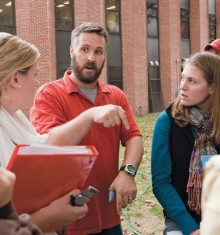

As a geochemist, Matthew Evans has traveled from the lowlands of North America to the very top of the world in the Himalayas to better understand how water and rocks interact. But it is his latest work, bringing small pieces of Antarctica to campus, that perhaps sheds the most compelling light on how our planet is currently changing.
Evans, assistant professor of chemistry and geology, is conducting research that is part of a three-year project that recently received $707,112 in funding from NASA. The grant is being divided among three institutions where scientists are collaborating on the project. Wheaton’s portion of the grant award is $96,904.
The project is an interdisciplinary study of the connections between recent ice sheet melt, sea ice decline and enhanced ocean biological productivity along the Amundsen Coast of West Antarctica. Evans is collaborating with scientists at NASA, Clark University and the Woods Hole Oceanographic Institution. The grant provides funding for students from all three institutions to participate in the research, and the results from the project will also be incorporated into undergraduate and graduate coursework.
Evans, along with some of his students, is studying samples taken from the rapidly retreating ice sheets of Antarctica. "We measure a sulfate compound called methanosulfonic acid (MSA), using the chemistry department’s ion chromatograph.” MSA is a by-product of phytoplankton growth and subsequent decay. Variations in MSA concentrations in coastal ice cores reflect changes in phytoplankton productivity and sea ice variability in adjacent seas. When sea ice is abundant, phytoplankton growth is reduced, and therefore less MSA is produced; when sea ice is absent, productivity increases and so does MSA. This means we can use the MSA record in ice cores as a proxy for sea ice growth and decay now, and in the past.
NASA’s involvement in the project stems from the space agency’s interest in comparing satellite images of the loss of the Antarctic ice mass with ground-truth studies by researchers at American colleges and universities.
"They have images going back to the late 1970s,” Evans notes, "and we can look at samples from these areas to examine the phytoplankton activity to help them better determine exactly what’s going on there with the sea ice. Our ice core chemical record has the potential to extend our understanding of sea ice past the satellite record.”

One of the key elements researchers are seeking to provide is a better understanding of any precedent for the rapid changes that are occurring in Antarctica, Greenland and elsewhere. The specific work being carried out by Evans and Wheaton students seeks to answer the question: Has this ever happened before?
"We’re really looking into the recent past to help us understand the more distant past and search for this type of activity,” he says.
Among the Wheaton students who have been assisting him are Claire Petersen, a senior from Tacoma, Wash., and Aurelie Marcotte ’10, who is now a graduate student at Arizona State University.
The research that Marcotte did on the project last year turned into her honors thesis at Wheaton. Her thesis focused on developing techniques to measure methanosulfonic acid using Wheaton’s facilities. "By demonstrating our ability to accurately measure MSA, Aurelie made Wheaton’s inclusion in the grant possible,” Evans says.
He sees this NASA research project as one of many approaches he and his Wheaton colleagues are using to bring compelling real-world science connected to their own work into the undergraduate experience here.
"The overall connection with this project is a good one for me,” he says. "And it is also a great fit for my students, as they are able to work with me and use the resources in the chemistry department to investigate real-world geologic problems.”